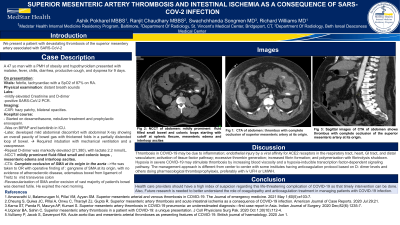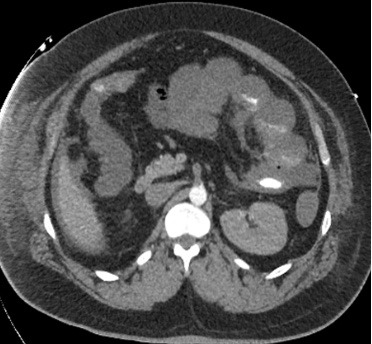Back


Poster Session B - Monday Morning
Category: Small Intestine
B0645 - Superior Mesenteric Artery Thrombosis and Intestinal Ischemia as a Consequence of Sars-Cov-2 Infection
Monday, October 24, 2022
10:00 AM – 12:00 PM ET
Location: Crown Ballroom

Has Audio

Ashik Pokharel, MBBS
MedStar Health
Baltimore, MD
Presenting Author(s)
Ashik Pokharel, MBBS1, Ranjit Chaudhary, MBBS2, Swachchhanda Songmen, MD3, Richard Williams, MD1
1MedStar Health, Baltimore, MD; 2St. Vincent Medical Center, Bridgeport, CT; 3Saint Vincent's Medical Center, Bridgeport, CT
Introduction: We present a patient with devastating thrombosis of the superior mesentery artery associated with SARS-CoV-2.
Case Description/Methods: A 47 yo man with a PMH of obesity and hypothyroidism presented with malaise, fever, chills, diarrhea, productive cough, and dyspnea for 9 days. He was febrile and tachycardiac with a SpO2 of 87% on RA. His breath sounds were distant. Creatinine and D-dimer were mildly elevated, and he had a positive SARS-CoV-2 PCR. CXR showed hazy patchy bilateral opacities. He was started on dexamethasone, nebulizer treatment, oxygen, and prophylactic enoxaparin. Subsequently, he was on BIPAP and baricitinib in the ICU. On hospital day 8, he developed mild abdominal discomfort, and an abdominal X-ray showed an overall paucity of bowel gas with thickened folds in a partially distended loop of bowel. On day 9, he required intubation with mechanical ventilation and a vasopressor. Repeat D-dimer was markedly elevated (21,380), with lactate 2.2 mmol/L. Non-contrast CT demonstrated mildly prominent fluid-filled bowel from the duodenojejunal junction to the splenic flexure, with mesenteric edema and interloop ascites. CTA showed complete occlusion of the SMA at its origin, with no evidence of atherosclerotic disease in the aorta and its branches. In the OR, a gangrenous bowel from the ligament of Treitz to the mid transverse colon was noted. Revascularization of the SMA and/or excision of the vast majority of the patient's bowel was deemed futile. He expired the next morning.
Discussion: Thrombosis in COVID-19 may be due to inflammation; endothelial injury by a viral affinity for ACE2 receptors in the respiratory tract, heart, GI tract, and distal vasculature; activation of tissue factor pathway; excessive thrombin generation; increased fibrin formation; and polymerization with fibrinolysis shutdown. Hypoxia in severe COVID-19 may stimulate thrombosis by increasing blood viscosity and a hypoxia-inducible transcription factor-dependent signaling pathway. The management approach is different from center to center with some institutes having anticoagulation protocol based on D- dimer levels and others doing pharmacological thromboprophylaxis, preferably with iv UFH or LMWH. Health care providers should have a high index of suspicion regarding this life-threatening complication of COVID-19 so that timely intervention can be done. Also, Future research is needed to better understand the role of coagulopathy and anticoagulation treatment in managing patients with COVID-19 infection.

Disclosures:
Ashik Pokharel, MBBS1, Ranjit Chaudhary, MBBS2, Swachchhanda Songmen, MD3, Richard Williams, MD1. B0645 - Superior Mesenteric Artery Thrombosis and Intestinal Ischemia as a Consequence of Sars-Cov-2 Infection, ACG 2022 Annual Scientific Meeting Abstracts. Charlotte, NC: American College of Gastroenterology.
1MedStar Health, Baltimore, MD; 2St. Vincent Medical Center, Bridgeport, CT; 3Saint Vincent's Medical Center, Bridgeport, CT
Introduction: We present a patient with devastating thrombosis of the superior mesentery artery associated with SARS-CoV-2.
Case Description/Methods: A 47 yo man with a PMH of obesity and hypothyroidism presented with malaise, fever, chills, diarrhea, productive cough, and dyspnea for 9 days. He was febrile and tachycardiac with a SpO2 of 87% on RA. His breath sounds were distant. Creatinine and D-dimer were mildly elevated, and he had a positive SARS-CoV-2 PCR. CXR showed hazy patchy bilateral opacities. He was started on dexamethasone, nebulizer treatment, oxygen, and prophylactic enoxaparin. Subsequently, he was on BIPAP and baricitinib in the ICU. On hospital day 8, he developed mild abdominal discomfort, and an abdominal X-ray showed an overall paucity of bowel gas with thickened folds in a partially distended loop of bowel. On day 9, he required intubation with mechanical ventilation and a vasopressor. Repeat D-dimer was markedly elevated (21,380), with lactate 2.2 mmol/L. Non-contrast CT demonstrated mildly prominent fluid-filled bowel from the duodenojejunal junction to the splenic flexure, with mesenteric edema and interloop ascites. CTA showed complete occlusion of the SMA at its origin, with no evidence of atherosclerotic disease in the aorta and its branches. In the OR, a gangrenous bowel from the ligament of Treitz to the mid transverse colon was noted. Revascularization of the SMA and/or excision of the vast majority of the patient's bowel was deemed futile. He expired the next morning.
Discussion: Thrombosis in COVID-19 may be due to inflammation; endothelial injury by a viral affinity for ACE2 receptors in the respiratory tract, heart, GI tract, and distal vasculature; activation of tissue factor pathway; excessive thrombin generation; increased fibrin formation; and polymerization with fibrinolysis shutdown. Hypoxia in severe COVID-19 may stimulate thrombosis by increasing blood viscosity and a hypoxia-inducible transcription factor-dependent signaling pathway. The management approach is different from center to center with some institutes having anticoagulation protocol based on D- dimer levels and others doing pharmacological thromboprophylaxis, preferably with iv UFH or LMWH. Health care providers should have a high index of suspicion regarding this life-threatening complication of COVID-19 so that timely intervention can be done. Also, Future research is needed to better understand the role of coagulopathy and anticoagulation treatment in managing patients with COVID-19 infection.

Figure: Axial image of CTA of the abdomen shows thrombus with complete occlusion of the superior mesenteric artery at its origin.
Disclosures:
Ashik Pokharel indicated no relevant financial relationships.
Ranjit Chaudhary indicated no relevant financial relationships.
Swachchhanda Songmen indicated no relevant financial relationships.
Richard Williams indicated no relevant financial relationships.
Ashik Pokharel, MBBS1, Ranjit Chaudhary, MBBS2, Swachchhanda Songmen, MD3, Richard Williams, MD1. B0645 - Superior Mesenteric Artery Thrombosis and Intestinal Ischemia as a Consequence of Sars-Cov-2 Infection, ACG 2022 Annual Scientific Meeting Abstracts. Charlotte, NC: American College of Gastroenterology.

